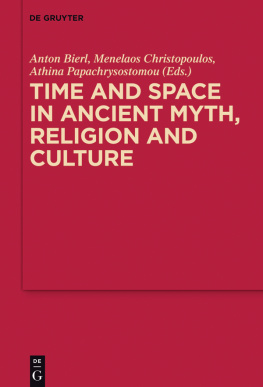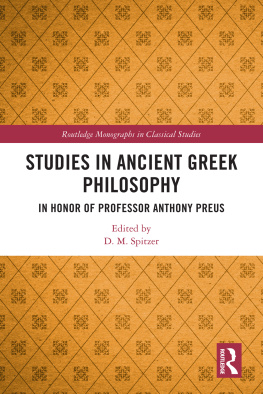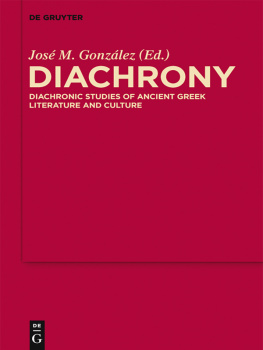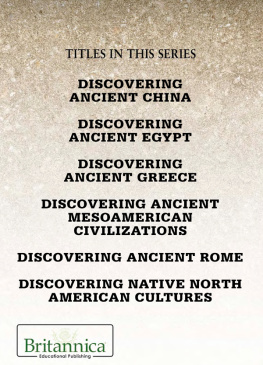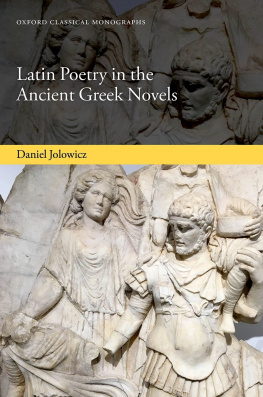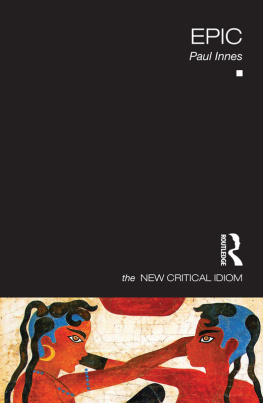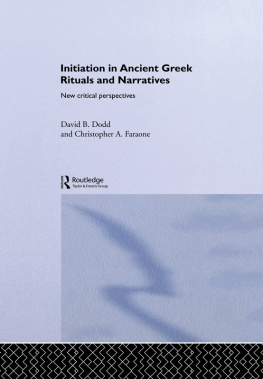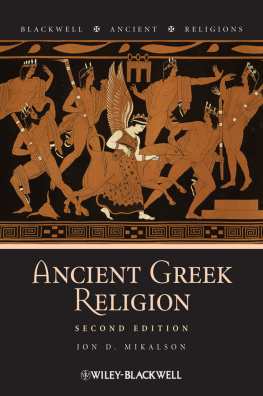Table of Contents
Guide

Time and Space in Ancient Myth, Religion and Culture
MythosEikonPoiesis

Herausgegeben von
Anton Bierl
Wissenschaftlicher Beirat:
Gregory Nagy, Richard Martin
Band 10

ISBN 978-3-11-053419-1
e-ISBN (PDF) 978-3-11-053515-0
e-ISBN (EPUB) 978-3-11-053422-1
ISSN 18685080
Library of Congress Cataloging-in-Publication Data
A CIP catalog record for this book has been applied for at the Library of Congress.
Bibliographic information published by the Deutsche Nationalbibliothek
The Deutsche Nationalbibliothek lists this publication in the Deutsche Nationalbibliografie; detailed bibliographic data are available in the Internet at http://dnb.dnb.de.
2017 Walter de Gruyter GmbH, Berlin/Boston
www.degruyter.com
Preface
The present volume on Time and Space in Greek and Roman Myth, Religion and Culture is the elaborate outcome of a project recently undertaken by the Center for the Study of Myth and Religion in Greek and Roman Antiquity, which is affiliated with the Department of Philology, University of Patras. This volume constitutes the logical sequence of the Centers previous publication, Light and Darkness in Greek Mythology and Religion , edited by M. Christopoulos, E. Karakantza and O. Levaniouk (Lanham 2000: Lexington Books).
Since the Centers establishment in 2007, many and diverse events and activities have taken place (talks, colloquiums, workshops, and conferences), in the attempt to explore as fully and deeply as possible various aspects of Greek and Roman myth and religion. What kept emerging from our discussions and research was the necessity to approach, examine, and try to interpret myth and religion from the point of view of two distinct parameters that essentially permeate the literary tradition, that is time and space . Hence, in July 2015 an International Conference was organised at Patras University, on Time and Space in Myth and Religion. This four-day Conference brought together scholars (classicists, archaeologists, and historians) from Europe, the US and Canada, who dealt with a wide range of notions (past, present, future; here, there, elsewhere) and themes (genealogies, time structure, topography, succession and flux), in multiple literary genres (epic and lyric poetry, tragedy, comedy, satyr drama and philosophy), and even in archaeology. The Conference adopted a cross-generic approach; its goal was to tackle key cases and discuss exemplary passages originating from the entire spectrum of the surviving material.
The present volume features the select and peer-reviewed proceedings of this International Conference. The chapters included herein were selected not only for their originality and academic merit, but also because they constitute crucial paradigms of how manifestations of myth and religion in Greek and Latin texts can dynamically engage in a variety of literary relations with the notions of time and space, thus leading to multifarious results (regarding theme, language, style, and narrative), such as rhetorical emphasis and pathos, narrative restructuring and dramaturgical function, intensification of literary patterns and motifs, time- and space-travelling, anachronisms and dj vus. In this regard, Mikhail Bakhtins (18951975) chronotope, the term of how time and space interfere with each other in specific temporal and spatial configurations, has perhaps proven the unifying concept of the entire volume.
The volume is divided in four parts: (i) epos, (ii) drama, (iii) empirical and imaginary chronotopes, and (iv) shifting chronotopes. The features a number of Strange Instances of Time and Space in Odysseus Return by M. Christopoulos, focusing on some unexpected aspects of time and space in Homeric Odyssey . The author studies the theme of Odysseus return to the same point from which he had departed, a theme which occurs four times in the Odyssey and seems to undermine the concept of the nostos itself. He also examines an interesting aspect of complementarity, in terms of time and space, between a sailing Odysseus and his weaving wife, Penelope, through the notion of sailing and weaving in which they mutually excel. Finally, the chapter explores some inconsistencies in Telemachus expected coming of age and access to manhood, issues which are removed towards an ulterior and undefined instance of time by the sole fact of Odysseus return.
The , by C. Antypas, deals with Calculating the Mythical Dimension: Time and Distance in Homeric Navigation. The author discusses how Homeric fiction needs to respect the actual experience of the audience, in order to construct a solid frame of realism for myth. Since the audience of rhapsodes were seashore people, the Homeric information about seafaring reflects the actual conditions of navigation of the era. Already by 800 BC, Greek sailors had restarted the exploration of the western Mediterranean. Probably, Polis Bay on Ithaca was the last port before the Greek sailors cross the Ionian Sea heading to Italy or Sicily and the first port of their return ( nostos ), after the wanderings in the western Mediterranean basin. In addition, Homeric information about night-faring, distances, and time of journey are revealed to reflect the reality of navigation by 8 th century BC, although under extremely favorable weather and sea conditions.
The , by J.S. Burgess, explores aspects of Land and Sea in the Odyssey and the Telegony , from the perspective of spatial theory. The polarity of land and sea is of great significance in Odyssean narratives. The Odyssey features its heros account of his wanderings at sea, striving to return to Ithaca, an island in the sea. The Homeric poem indicates that Ithaca has various politico-economic connections to the mainland, and some of Odysseus lying tales feature Thesprotia on the mainland. Tiresias imposes a geographically obscure inland journey on Odysseus, and his prediction of death from the sea for Odysseus centers on the spatial binary of land/sea. In the Telegony the hero journeys to both Elis and Thesprotia, before returning to Ithaca, where death arrives from the sea. In ancient stories of Odysseus the polarity of land and sea is prominent, and the spatial status of Ithaca as both land and sea, with all the ambiguity and paradox that this involves, is essential to understanding myth and literature about Odysseus.
The following, etry several descriptions may be found of altars built close to a source ( pege ) or a fountain ( krene ). This chapter examines the possible relation between the pure water emerging from earth and the blood poured on the altar. Far from proposing a single answer, the author observes how different poetical genres suggest different ways of approaching this correlation; for example, at the beginning of Hesiods Theogony , the fountain and the altar around which Muses dance appear to be an essential indication of good order.
The , by E. Peraki-Kyriakidou, discusses the figure of Iris as Messenger and Her Journey: Speech in Space and Time, as presented in Homer, Apollonius Argonautica , Virgils Aeneid , and Ovids Metamorphoses . In the Iliad what matters is Iris swiftness; neither her visual characterization nor the space she travels through is of importance. In Apollonius Argonautica , the travelling space is again of secondary importance. In the Aeneid Iris visual characterization is more important, while there is a shift of interest to the travelling space itself. The space now is blown up with colours left by Iris herself as she passes; in a way, Iris becomes the space itself. Ovid, in his Metamorphoses , goes one step further: the poet presents Iris as travelling invested in colours, which are not her own. Since Iris is recognized in scholarship as an epic voice and an embodiment of tradition, in a metapoetic reading the visualization of the original word is affected by countless different influences in its course.

